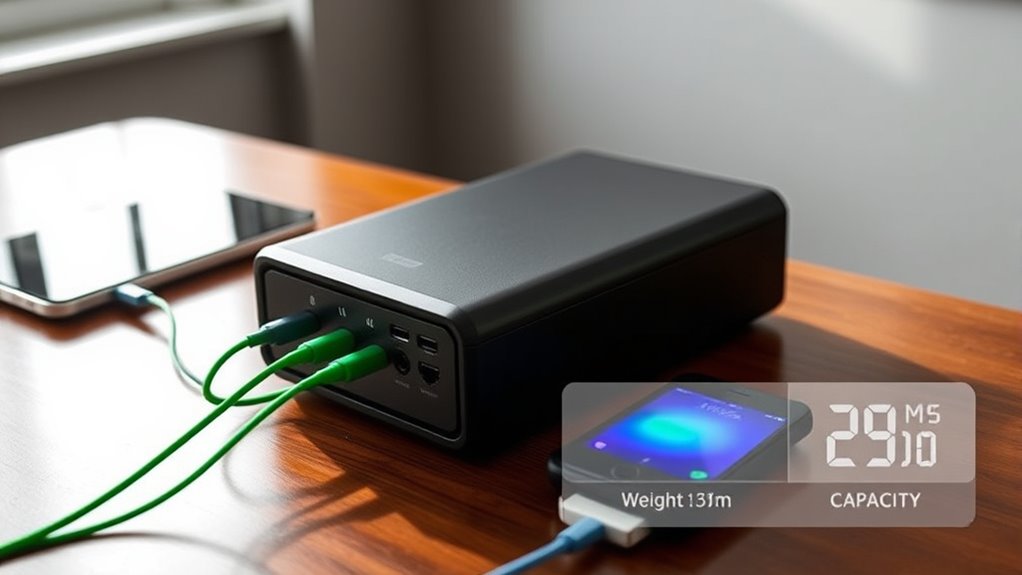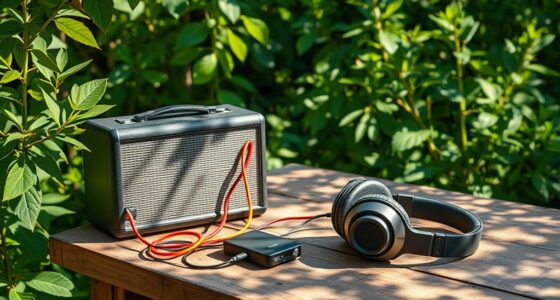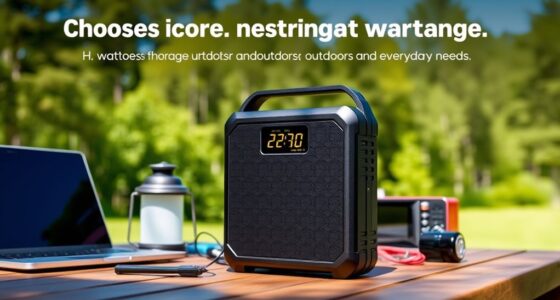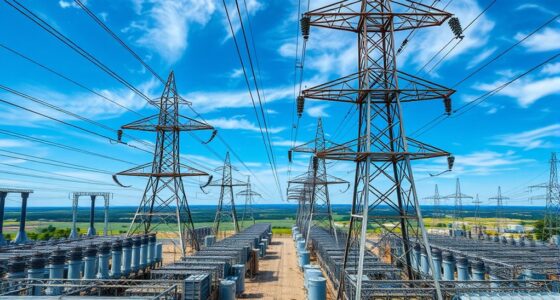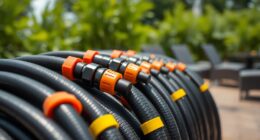When choosing a portable power station, both weight and capacity matter, but which is more important depends on how you’ll use it. If you move it often or have to carry it over distances, lightweight units are better, even if capacity is lower. However, for longer outages or powering multiple devices, a higher capacity ensures more runtime. Knowing your specific needs helps find the right balance, and understanding the trade-offs can make a big difference in your choice.
Key Takeaways
- Consider your mobility needs; lighter units are easier to transport during outdoor adventures.
- Higher capacity extends device runtime but increases weight, impacting portability.
- Balance solar efficiency and weight; larger panels recharge faster but add bulk.
- Longer battery lifespan ensures durability but often results in heavier, more expensive units.
- Match power station size to usage frequency and device requirements for optimal convenience.
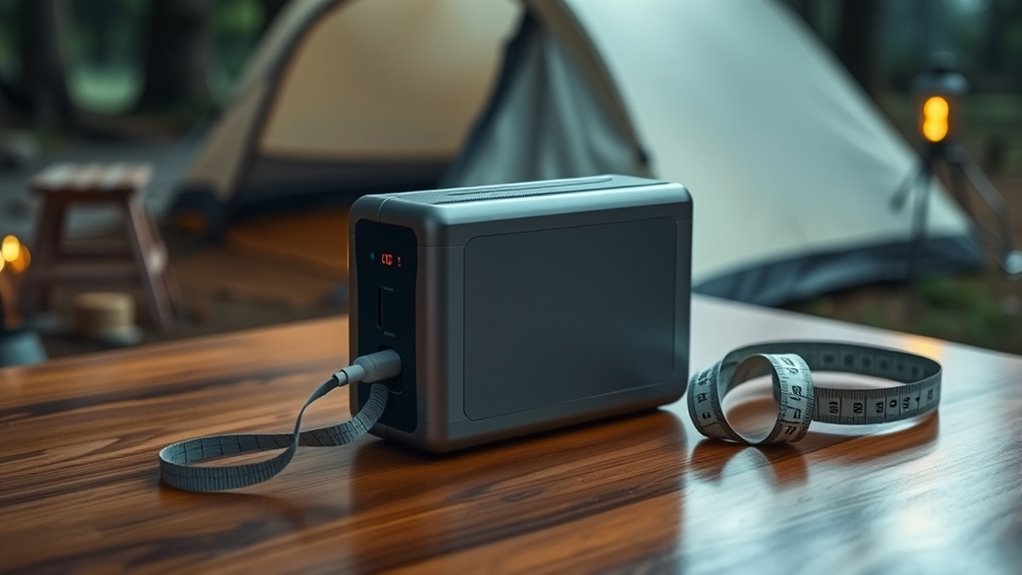
When choosing a portable power station, understanding the trade-off between weight and capacity is essential. You want a device that can power your devices reliably without becoming a burden to carry around. As you evaluate options, consider how weight impacts your mobility and convenience, especially if you’ll be using the station in outdoor activities like camping or hiking. A heavier unit often means higher capacity, which translates to longer runtime and more power for your devices. However, increased capacity usually comes with added weight, which can make transportation cumbersome. Finding the right balance means appraising how often you’ll need to move the station and how much power you require during your outings. Additionally, pay attention to the balance of weight and capacity to ensure your choice aligns with your specific needs. Beyond just capacity, pay attention to the solar efficiency of the power station if you’ll be relying on solar panels for recharging. Solar efficiency determines how quickly and effectively the station can harness sunlight to replenish its batteries. A more solar-efficient model can save you time and effort, especially in remote locations where grid power isn’t available. Keep in mind that solar efficiency is often influenced by the size and quality of the solar input, which can also impact the overall weight of the system. Larger solar panels provide better solar efficiency but add to the weight you’re carrying, so you’ll need to weigh the benefits of faster charging against portability. Battery lifespan is another critical factor that intertwines with your choice. A longer-lasting battery means you’ll be able to use your portable power station for years without significant degradation in performance. While a battery with a more extended lifespan might be slightly heavier or more expensive initially, it can save you money and frustration over time. Cheaper batteries tend to wear out quicker, reducing the station’s capacity and reliability. When evaluating your options, consider how the battery lifespan aligns with your usage patterns and whether investing in a higher-quality, possibly heavier, battery makes sense for your needs. Ultimately, what matters more depends on your priorities. If you’re frequently on the move and need lightweight gear, you might prioritize lower weight over maximum capacity, even if it means shorter usage times. Conversely, if your trips are longer or involve multiple devices, opting for a higher capacity with a robust battery and good solar efficiency could be more beneficial, despite the added weight. Balancing these factors ensures you select a portable power station that fits your lifestyle and energy needs without sacrificing too much convenience or performance.
Frequently Asked Questions
How Does Weight Affect Portability in Real-World Scenarios?
Weight directly impacts your portable convenience, making it easier or harder to carry your power station. When weight is well-distributed, it feels lighter and more balanced, reducing strain during transport. In real-world scenarios, a lighter device lets you move freely, whether camping or during emergencies. So, consider both weight and weight distribution to guarantee your power station remains easy to carry and practical for your needs.
Can a Lighter Power Station Still Meet High Energy Demands?
Like David facing Goliath, a lighter power station can still meet high energy demands if it boasts excellent battery efficiency. You won’t have to worry about excessive noise levels or sacrificing performance. Modern tech allows compact units to pack a punch, ensuring you get reliable power without the bulk. So, yes, a lighter portable power station can deliver the energy you need, just stay mindful of its efficiency and noise output.
Is There a Trade-Off Between Capacity and Durability?
You might wonder if increasing capacity affects durability. Generally, larger batteries can strain materials, reducing battery lifespan if not designed well. Robust materials help maintain longevity, even with higher capacity. When selecting a portable power station, consider how material durability impacts its ability to withstand frequent use. Balancing capacity with solid build quality ensures your device remains reliable and long-lasting, avoiding premature wear and tear.
How Do Different Materials Influence Weight and Capacity?
Different materials considerably influence a portable power station’s weight and capacity. Material composition, such as lightweight plastics versus heavy-duty metals, impacts overall weight, making it more portable or sturdy. Manufacturing processes also play a role; advanced techniques can enhance durability without adding weight. When choosing a power station, consider how material choices balance weight and capacity, ensuring it meets your portability needs without sacrificing performance.
What Are the Best Practices for Transporting Heavy Power Stations?
When transporting heavy power stations, prioritize battery technology and ergonomic design. Use sturdy handles or straps for better grip, and consider a wheeled cart or case to reduce strain. Make sure the device’s weight distribution is balanced to avoid injury. Always lift with your legs, not your back, and plan your route to minimize obstacles. Properly securing the station prevents accidents and protects both you and the device.
Conclusion
Remember, while weight influences portability, capacity determines how long you’ll stay powered. Don’t let a lighter station deceive you into sacrificing your essential needs. Sometimes, a slightly heavier unit offers much more runtime and reliability, making it worth the extra effort to carry. Prioritize what matters most for your adventures—longer power or easier transport—and choose wisely. Ultimately, balancing both ensures you stay connected without overloading yourself.
